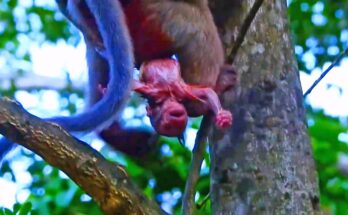Search
Study
In the heart of the jungle or along the edges of bustling towns, scenes from nature often reveal both its tenderness and its harsh realities. One such moment is captured in the sight of a monkey baby drinking milk—a moment that tugs at the heartstrings with its blend of innocence and sorrow. The tiny creature, with its fragile body and expressive eyes, clings tightly to a bottle or its mother’s chest, desperately sucking for nourishment. It is an image that evokes warmth and affection, yet beneath the surface lies a quiet story of vulnerability and survival.
The adorable side of this moment is undeniable. The baby monkey’s small hands wrapped around the bottle or its mother’s fur, the gentle tilt of its head, and the soft sounds it makes while feeding—all radiate a sense of purity and dependence. These gestures remind us of the universal bond between parent and child, transcending species. Just like a human infant, the monkey baby’s need for milk symbolizes comfort, love, and security. Watching such a scene can easily melt anyone’s heart, inspiring feelings of tenderness and compassion.
However, this pitiful side often tells a different story—especially when the baby monkey is seen drinking milk from a human bottle rather than its mother. This can indicate separation, abandonment, or the harsh consequences of human interference with wildlife. Many young monkeys found in captivity or on the streets are orphaned or taken from their natural habitats. Their adorable, human-like features often make them victims of exploitation for entertainment or photography. Behind the sweetness of the image, there may be loneliness, hunger, and fear.
The moment of a monkey baby drinking milk thus becomes a reflection of two worlds colliding: the nurturing beauty of nature and the tragedy of disruption caused by human activity. It reminds us that while animals can adapt to human care, they truly belong in the wild, where their instincts and family bonds flourish naturally.


